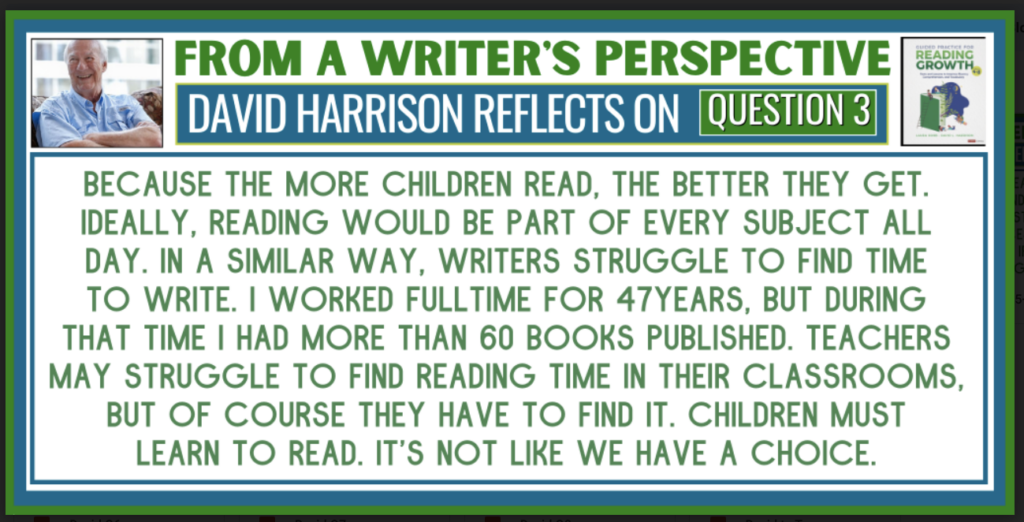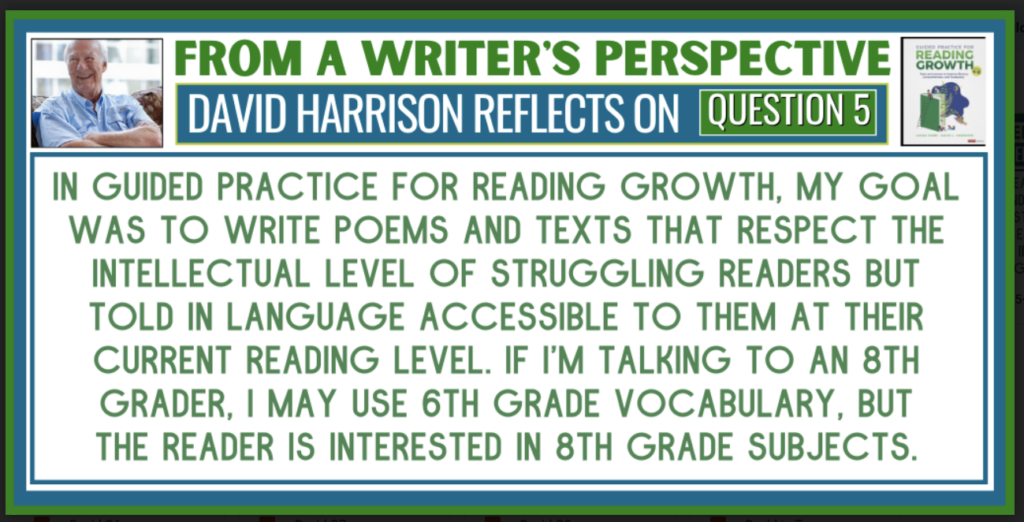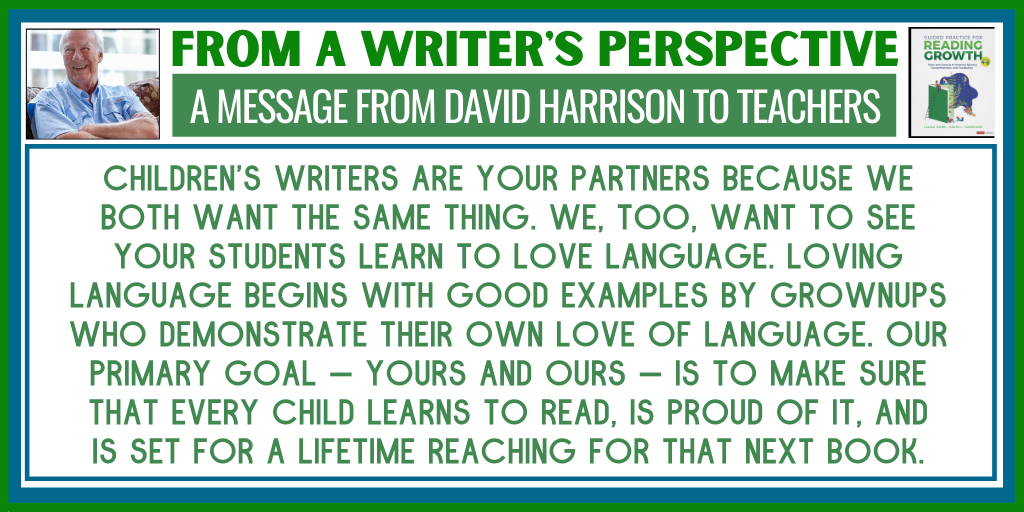By Fran McVeigh
Laura Robb is no stranger to #G2Great. She frequently participates in our weekly chats and has been a guest host with principal son and coauthor, Evan Robb, for Schools Full of Readers: Tools for Teachers, Coaches and Leaders to Support Students. This link gives you access to the blog post and wakelet for that book. Laura and Evan Robb coauthored this blog post in 2020, “Breaking the Cycle of Professional Compliance: Teachers as Decision-Makers.” (Link) It was truly a pleasure to welcome Laura and her coauthor David Harrison to his first chat this week.
Routines. Habits. As I drove, I hit my turn signal. It was automatic. I had driven this route for years. More years than I can count (or remember). But I had to reach down and turn that signal off because that’s not the route anymore. Change. It requires thought and a conscious effort. Changing habits and routines is hard. What will make this travel change MORE automatic? More practice!
Teaching.
Teaching also requires thought and conscious effort. Teaching requires so many decisions that teachers need to consciously make. Gravity Goldberg and Renee Houser tell us that teachers make 1500 decisions per day (Edutopia link). It’s exhausting and yet equally stimulating to make decisions that matter for students. We must TRUST teachers to make decisions that will increase student joy AND student learning.
What is the end goal? Here is Laura Robb’s response.
What is a message from the heart you would like for every teacher to keep in mind?
Teach the children in front of you. Get to know them. Watch. Listen. Have conversations with them. Read their notebooks. Increase their reading stamina with daily independent reading of self-selected books. Respond to their needs by knowing and building on their strengths. Become a responsive teacher who can adapt instruction and interventions to students, knowing that their needs change throughout the school year. Remember, that volume in reading is the best intervention and can develop students’ joy in reading, positive reading identities, and create lifelong readers!
Laura Robb, email.
I wrote this book blurb for Corwin Press after the first time I read Guided Practice for Reading Growth and now after the third reading I believe it to be even more true.
Book Blurb: Guided Practice for Reading Growth
“What is essential for reading growth? David Harrison and Laura Robb provide guidelines and tips for schedules, routines, instructional practices and lessons that improve students’ reading skill and self-confidence with proven sustained growth by real students in real classrooms. The authors use the research and their classroom work to provide evidence that students working below their grade level do not need pre-made programs or one-size basals but do need knowledgeable teachers who know their students and align and craft guided practice that encourages students to work hard to meet their goals. This book details how guided practice reinforces and enhances independent reading, interactive read-alouds, vocabulary building and writing about texts in a reader’s notebook. The implementation of the ideas in this book will help teachers develop effective and efficient targeted instruction that capitalizes on teacher knowledge and relationships with the students in their classrooms.”
Fran McVeigh, email.
Three big ideas form the focus of my thinking and understanding about this book based on Laura and David’s ideas, my previous work with middle school students, and the nature of curriculum/intervention plans and resources for middle school students. Let’s explore.
Instruction that meets the needs of students must be carefully crafted and implemented
No one lock-step, one-size-fits-all curriculum works. I see students in middle school and high school who are “not proficient” in reading. I am over-generalizing, but basically that means they missed a cut-off score on some skill area. Some argue that they must ALL need phonemic awareness or phonological awareness if they are struggling in reading. But what of students who have been a part of explicit phonics instruction who year after year are given another NEW phonics program because the last one was not successful and they are now down to literally TIER 6 in phonics programs and have very little time READING but spend much of their time in drills and isolated word work? Students are frustrated, disheartened and tired of “work that makes them feel stupid.”
Instruction can be so much more for students. The lessons Laura and David provide in Guided Practice for Reading Growth can be used “just in time” for student practice that they need NOW. Not after a data team meeting, but NOW to allow students to make accelerated growth without waiting for the roulette wheel to spin up their name at a pre-designated review.
David’s stories and poems are an excellent catalyst for instruction. The lessons Laura crafted are easily replicable by teachers. There are two sets that teachers are encouraged to make their own. Trusting that teachers know the students best, there is a set for partner discussion and a set for shared reading which lead to student writing. Talk. Writing. Part of the reciprocal action cycle of reading.

And then the finale. Part III in the text is “Next Steps for Guided Practice and Growth in Reading.” The beauty of adding in fluency practice that is self-selected and performed by students is tantalizing. Maximizing efficiency and effectiveness with teacher data-based decisions about how to structure time and resources to meet student resources is teacher autonomy at its best!
Choice and agency are necessary for students to grow as readers.
Independent reading is a daily expectation in this structure. Students are allowed to choose texts that align with their interests. Teachers are encouraged to choose texts that students will find engaging.
Fluency practice as presented in this text is never reduced to reading rate, but instead, is all about the interpretation and the love of language. Empowering teachers. Empowering students. Empowering student learning. Empowering student progress. Empowering students as leaders. And again, providing practice opportunities for students to do the work themselves and choose their own reading materials!
Student reading identities matter.
Students have to find both the joy and belief in their own ability to read. By middle school and high school this is not easy. Some students have already fake read the same book three or four years in a row. Other students are quite good at shrugging off the “I’m too busy to read. Check out my activities” excuses. We’ve known about the importance of reading and writing identities but often not had the time, energy, resources or support necessary to grow identities. Successful and powerful reading and writing identities that respect their age, emotional maturity, and are worthy of both student and teacher time and attention. Choice and scaffolded instructional times provide opportunities for student identities to grow and mature.

This is further emphasized in the authors’ responses to the remaining questions.
What are your BIG takeaways from your book that you hope teachers will embrace in their teaching practices?
The first big takeaway is to use formative assessments and relentless kid watching to identify students’ strengths and build on these strengths with guided practice lessons. Guided practice lessons are short, focus on what students need, and invite them to do the thinking and work that can improve their reading and enlarge vocabulary. The next big takeaway is that volume in reading is an intervention that can bring students reading below grade level into the reading life and develop their reading identities.
Laura and David, email.
What motivated you to write this book? What impact did you hope that it would have on the professional world?
My work with fifth grade students entering school reading at a kindergarten to early second grade reading level pushed me to rethink reading instruction and intervention. Besides having them read self-selected books every day for about 20-minutes, I began developing guided practice lessons using short texts to engage them in deep thinking, meaningful discussions, and writing about reading. Another goal was to enlarge their vocabulary and background knowledge, and watching short videos prior to reading worked well. Students loved them, but if a few needed to revisit the video, it was easy for them to watch it a second or third time on their own or with a small group. With award-winning poet, David Harrison, writing the poems and short texts for the guided practice lessons, students can read culturally relevant texts on topics they suggested through surveys conducted in grades five to eight
David and I hope that teachers of grades 4 to 8 will integrate guided practice lessons into their instructional reading. Once teachers try the lessons, there are guidelines in the appendix for developing their own guided practice lessons. To support teachers as they get started with developing lessons, David Harrison wrote extra poems and short texts that are in the appendix; there’s also a list of magazines teachers can mine for short tests and lists of poetry collections to investigate. The goal is for teachers to intervene as soon as they observe students require extra practice and gradually release responsibility for learning to students.
Laura Robb, email.
In conclusion, just as students need carefully crafted instruction, with choice and agency as well as support for reader and writer identities – so do teachers! Guided practice is a simple, yet practical way to provide students with opportunities to joyfully develop into lifelong readers who can and do read.
The Last Word: What would you like teachers to know? David’s response
